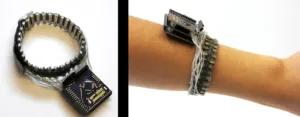A research team within the Human-Computer Interaction Institute at Carnegie Mellon University (Pittsburgh, Pa) is developing a means to detect hand gestures through the use of an “instrumented smartwatch.” The smartwatch is enabled with the capability for Electrical Impedance Tomography (EIT).
The team is headed by Ph.D. student Yang Zhang. A recent article on the subject is entitled “Advancing Hand Gesture Recognition with High Resolution Electrical Impedance Tomography” and was presented as part of the Proceedings of the 29th Annual ACM Symposium on User interface Software and Technology held between October 16 – 19 in Tokyo, Japan. A copy of the article can be found here.
The name given by the team to the technology used in the smartwatch is ‘Tomo’. The team has previously reported on this technology. This most recent work is called Tomo2 and reports on a new version of the system that offers improved sampling speed, resolution and gesture recognition capability.
The Tomo system is based on the use of tomography. This is described in the article as “an imaging technique that estimates the cross-sectional interior structure of objects through the use of an external, penetrating signal.” Specific to the smartwatch application, the team used a version of tomography called Electrical Impedance Tomography (EIT) which is based on multiple, wrist mounted surface electrodes and high frequency alternating current. The system is capable of measuring the internal electrical impedance of the user’s wrist. By this means, it is possible to reconstruct the internal impedance distribution of the wrist and to and infer its’ interior structure. Based on the details of the internal structure of the wrist, it is possible, in turn, to determine the configuration and movement of the wrist. In sum, it is possible to determine the gesture made by the user wearing the smartwatch.
The researchers make particular note of the fact that EIT is:
- Safe for long-term continuous operation since it operates using a low voltage and does not use ionizing radiation.
- Non-invasive to the wearer since it rests on skin (without the need, for example, of a conductive gel).
- Can be made inexpensively (~$50).
As reported in this recent article, the Tomo2 system was used as a platform for experimentation. More specifically, the team compared two EIT sensing methods and three different electrode resolutions.
The first type of EIT sensing is called “two pole” sensing. In this approach, impedance measurements are captured from each pair of electrodes in contact with the user’s skin. One electrode acts as an emitter and the other as a receiver. This method is affected by skin impedance with the result that larger electrodes are typically used for greater contact area with the skin. This, in turn, limits the ability to implement a dense electrode array. None-the-less, this approach is widely used due to the fact that it is considered technically simple. The second type of EIT uses a more sophisticated “four pole” scheme. In this approach, an adjacent pair of electrodes are excited with an AC signal and the voltage is measured between another pair of electrodes. This process is repeated for all possible emission and measurement electrode pairs within the array.
The team designed their test EIT system such that it could be switched between two and four pole sensing schemes, as well as between 8, 16 and 32 electrode configurations.
The first top level result of experiments with these six possible configurations is that increasing the electrode count improved recognition accuracy. This was in spite of the fact that increasing electrode resolution requires that the electrodes must also be smaller, reducing the contact area with the skin. This, in turn, made the electrodes more susceptible to variations in skin contact condition which, in turn, reduced the quality of the results produced by the tomography technique.
A second result was the determination that a differential measurement approach made the four pole sensing approach less sensitive to skin contact conditions. It followed that the four pole approach was found to have greater sensing accuracy than two pole sensing.
One interesting data point is that the system could complete a single measurement in just 0.33ms, which allows the achievement of 100 frames per second in a two pole, 8 electrode configuration.
At this time, the team reports that the system can only recognize discrete hand gestures. None-the-less, it is felt that, with further development, it is likely that other gestures can be detected.
In future research, the team hopes to investigate technical improvements to the system. This includes using (or combining) different excitation frequencies and swept frequency excitations. The team also wants to explore the so-called “auto rotation” approach. This approach had previously demonstrated a high-density EMG sensor band that automatically detected the orientation with respect to the wearer’s arm. This orientation data was used to digitally rotate the signal in order to provide accurate classification of orientation regardless of how the user wore the device. -Arthur Berman
Human-Computer Interaction Institute, Yang Zhang, 412-330-8667, [email protected]

